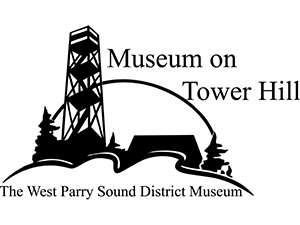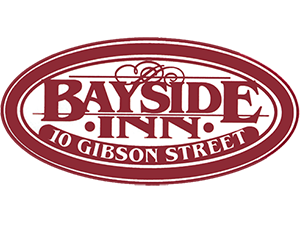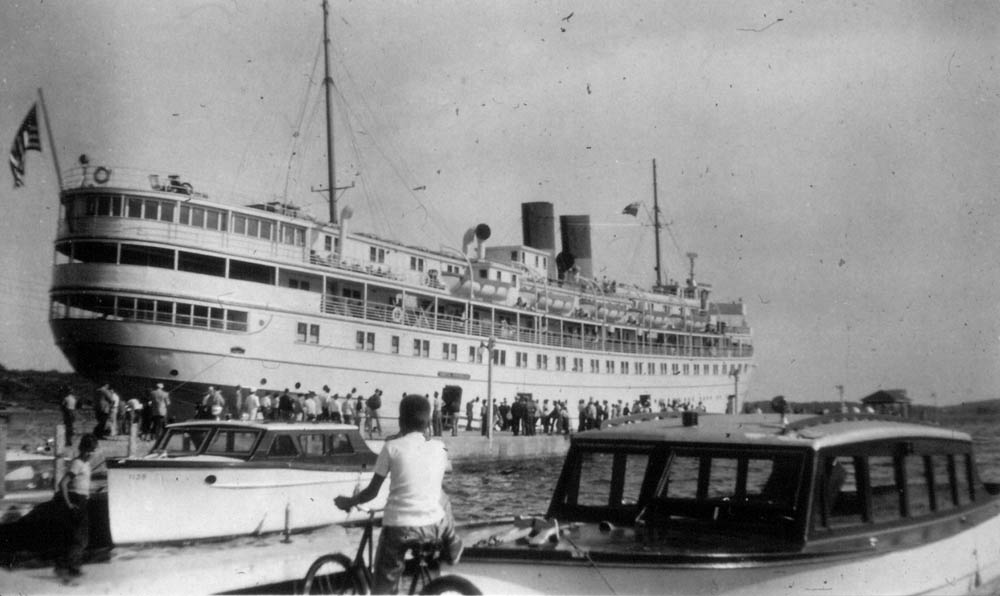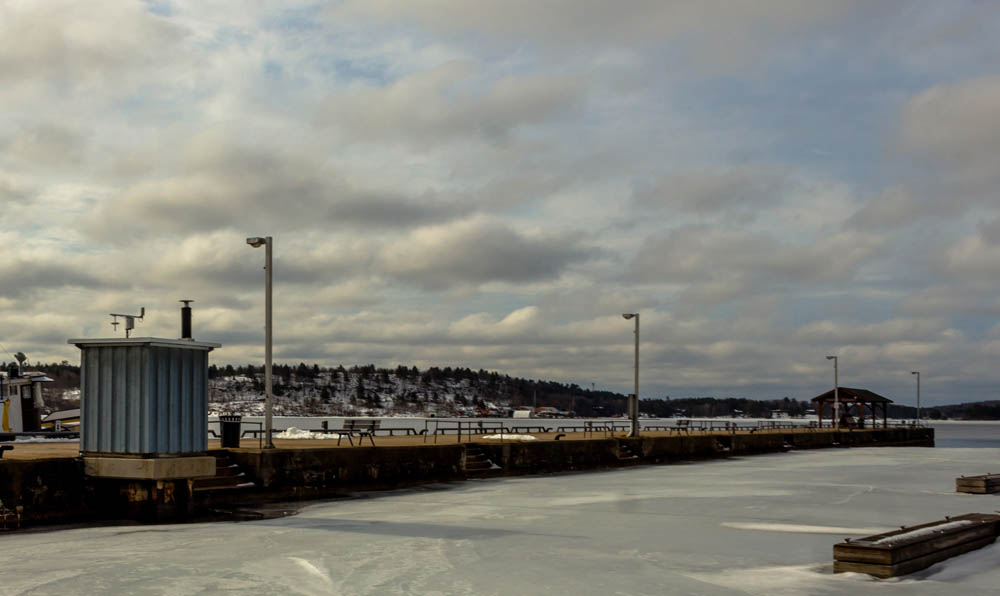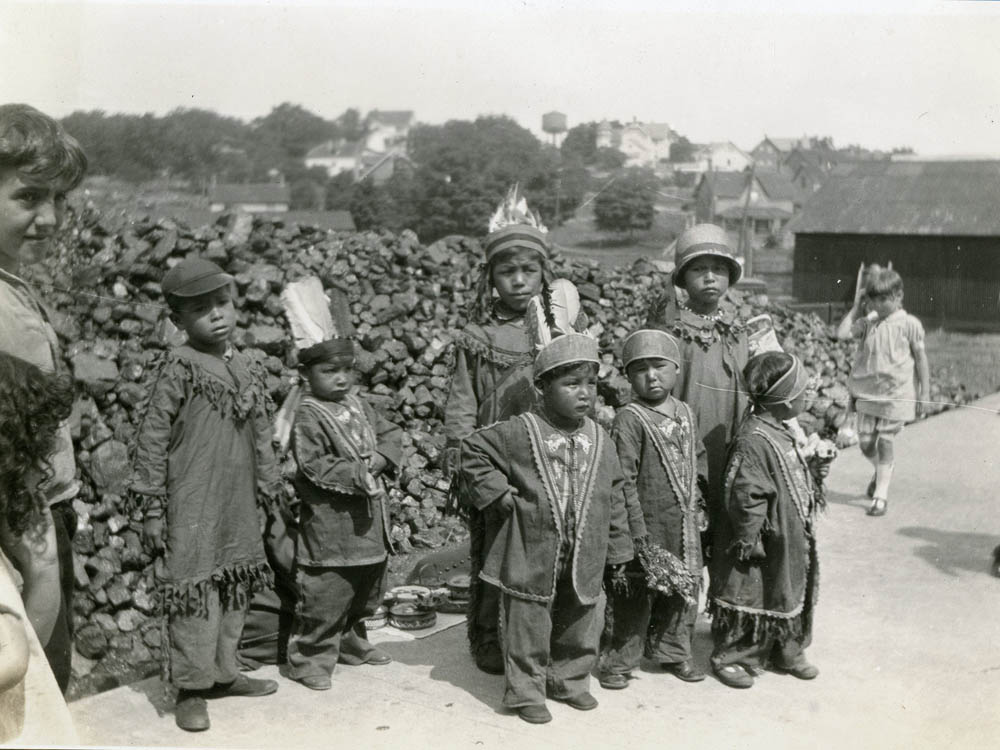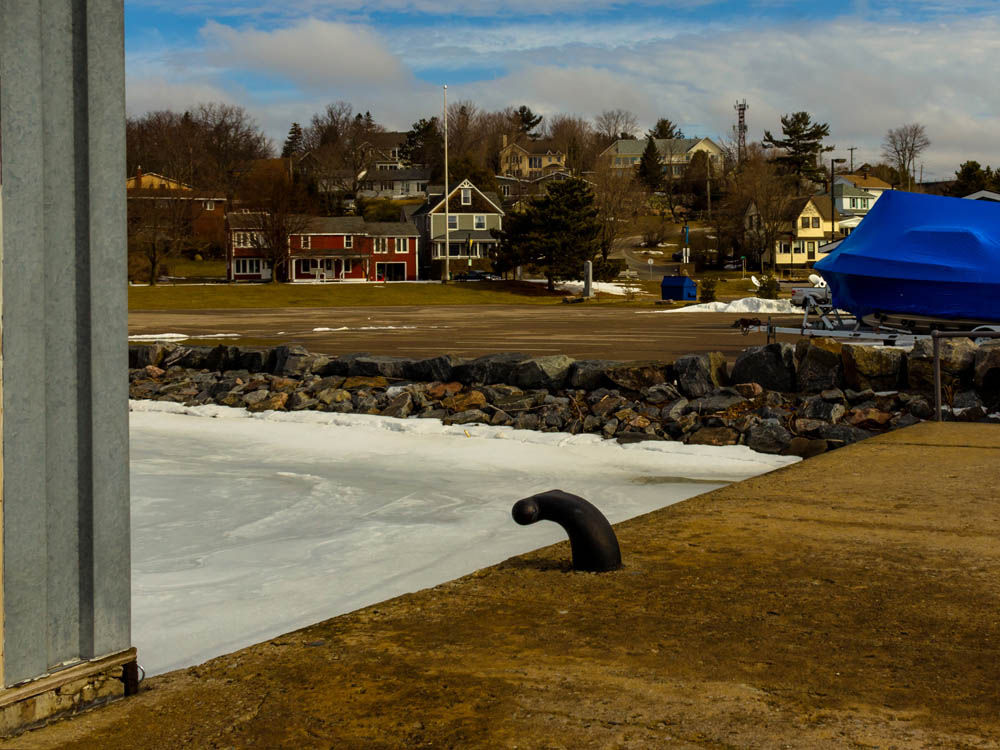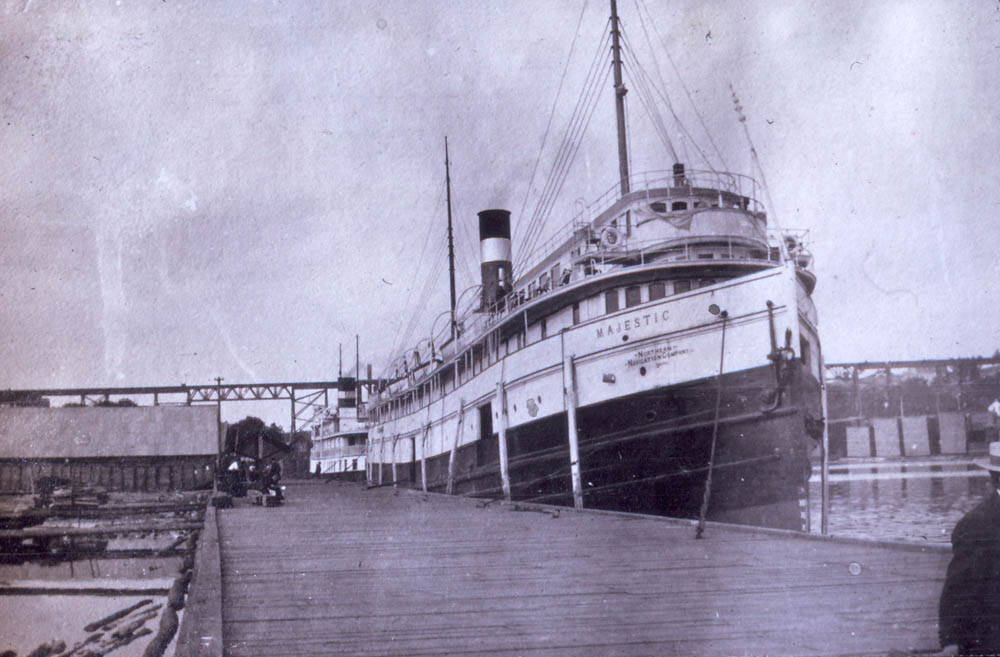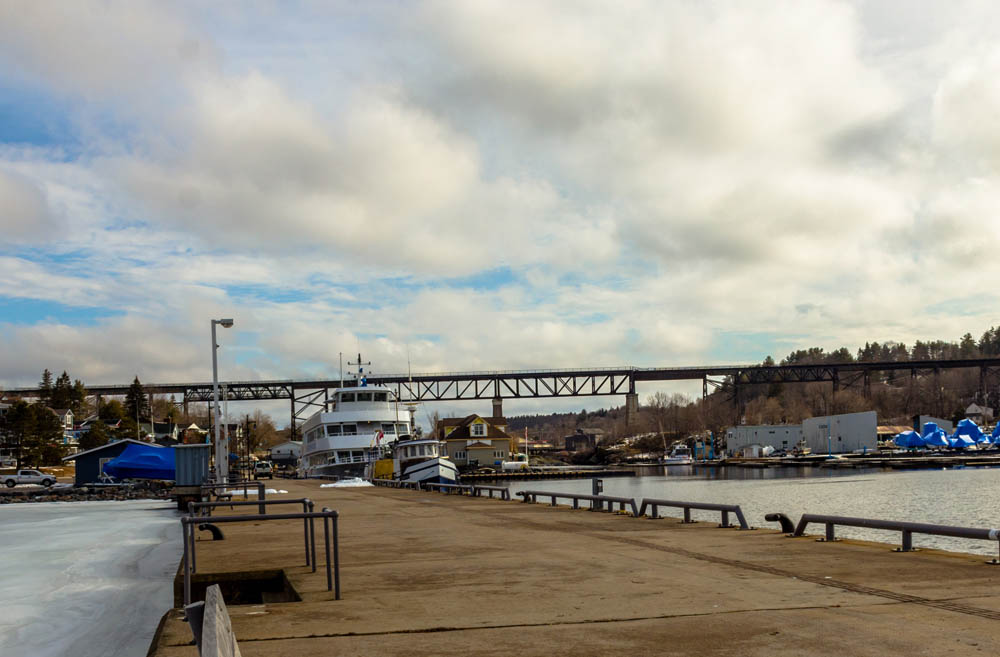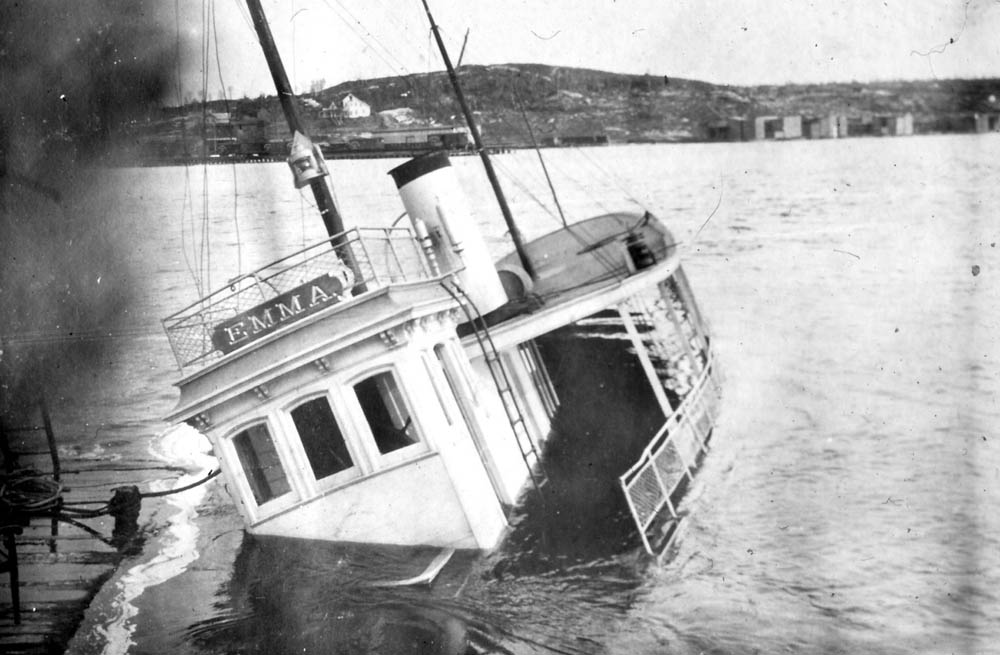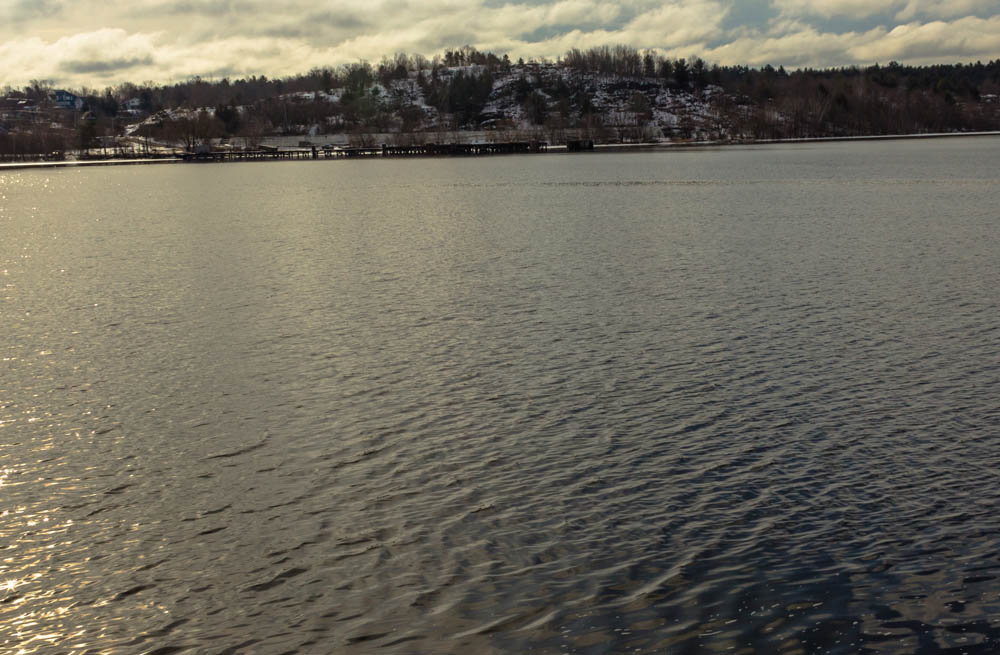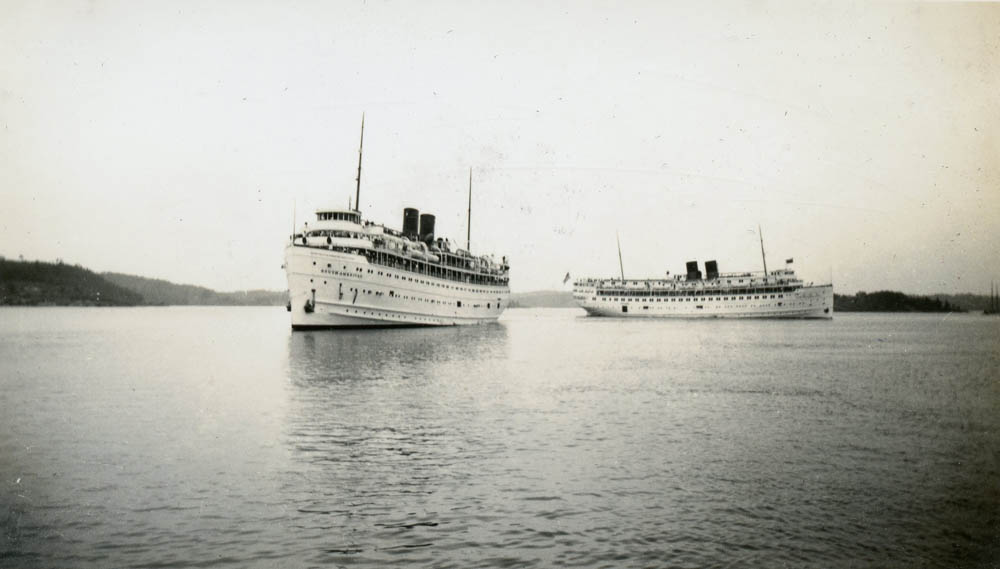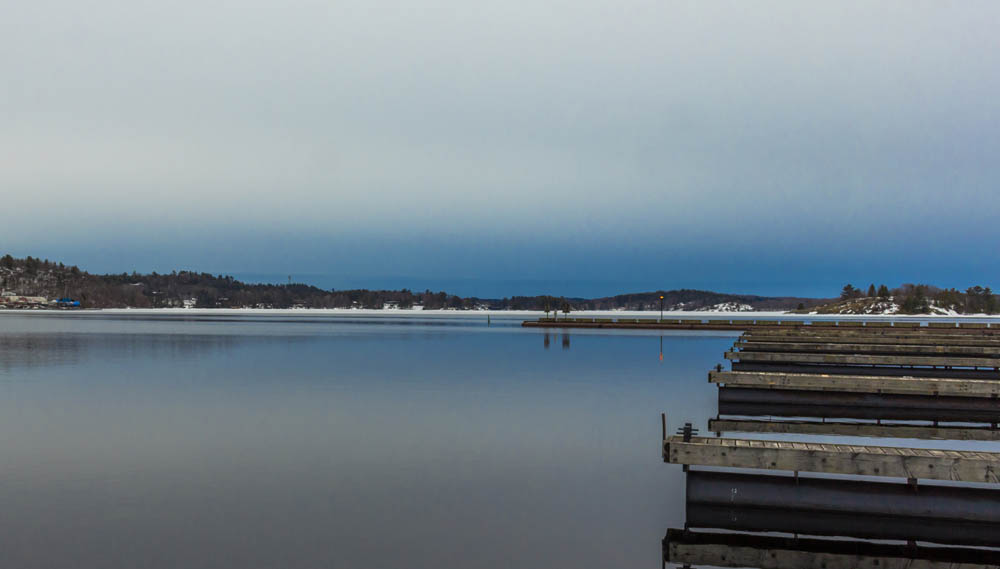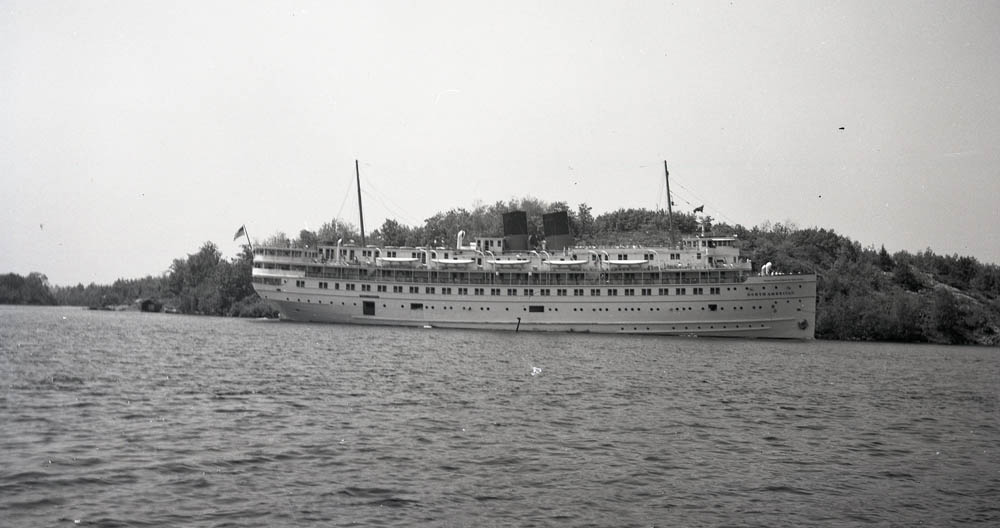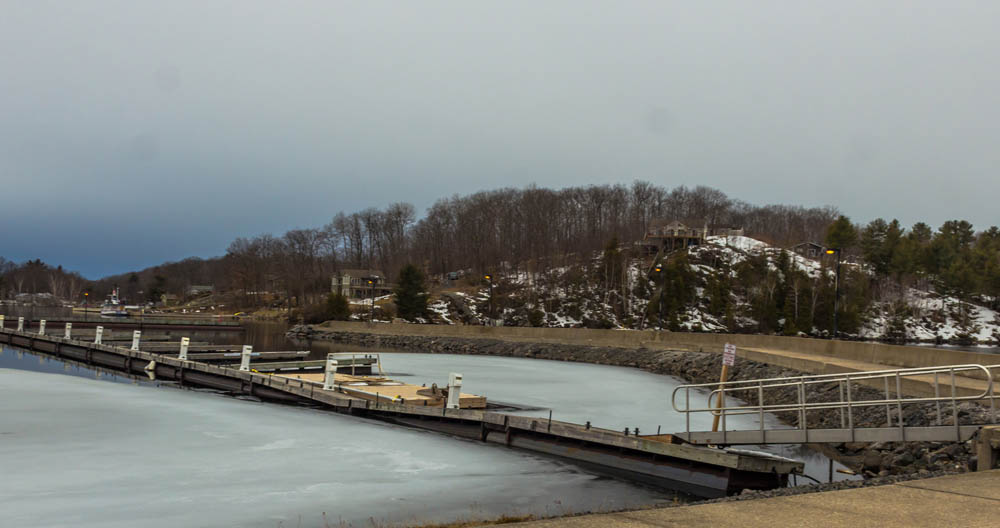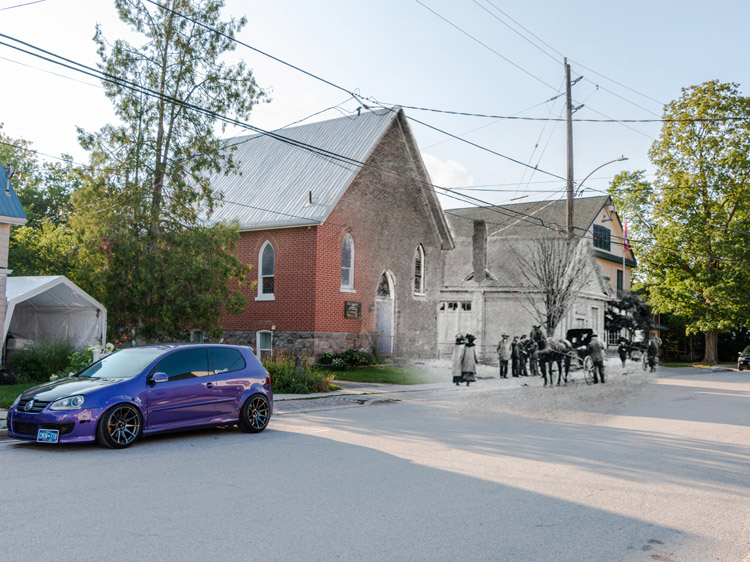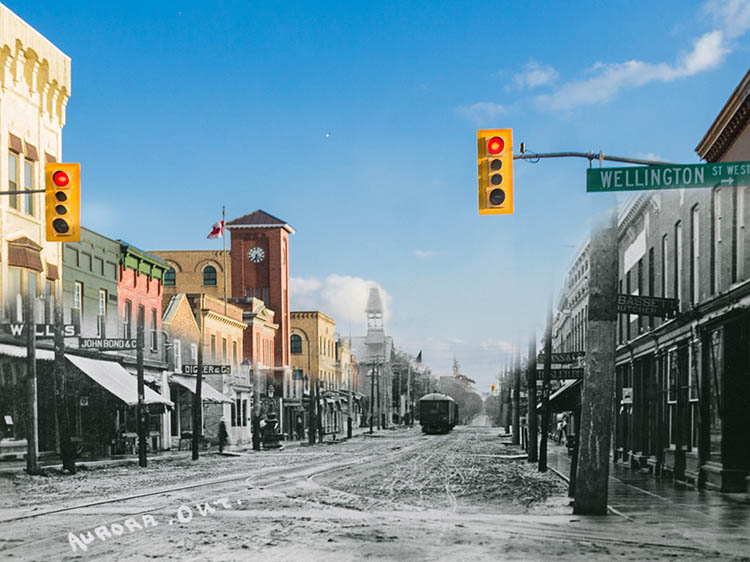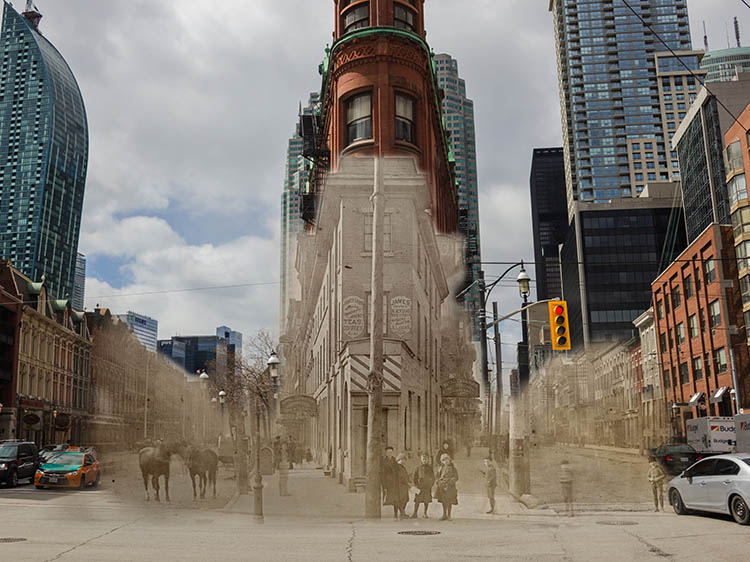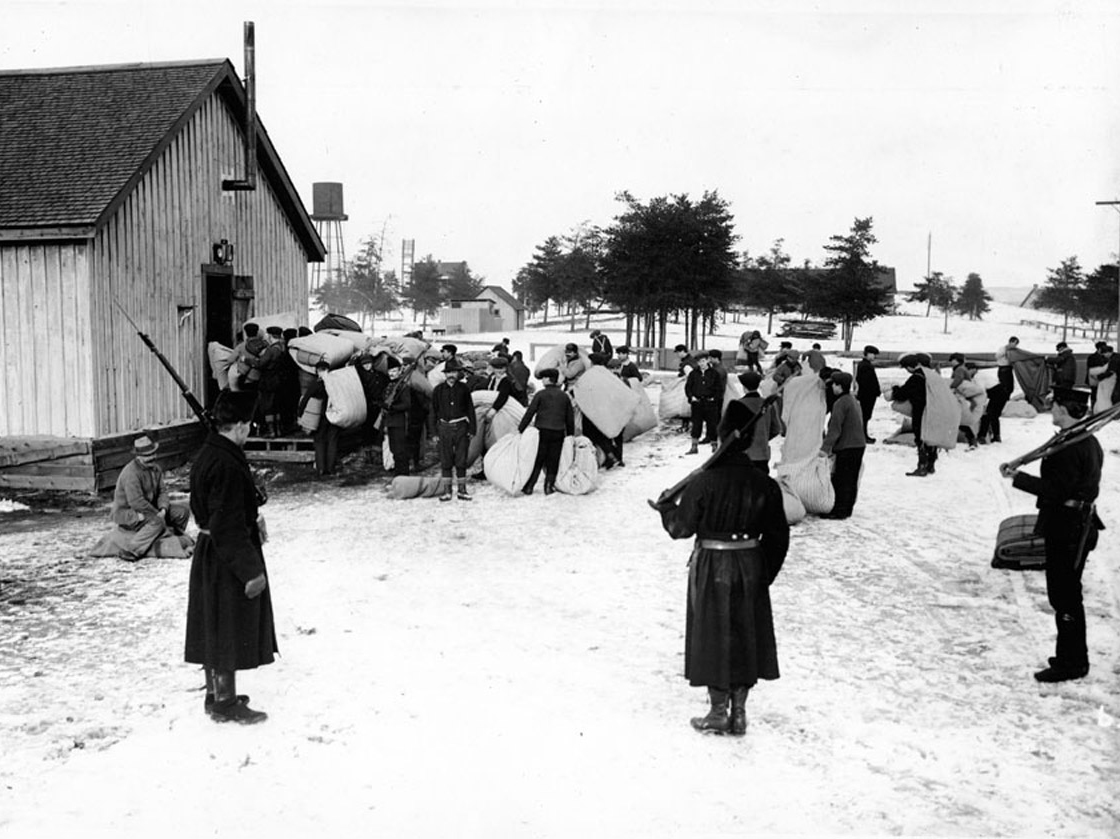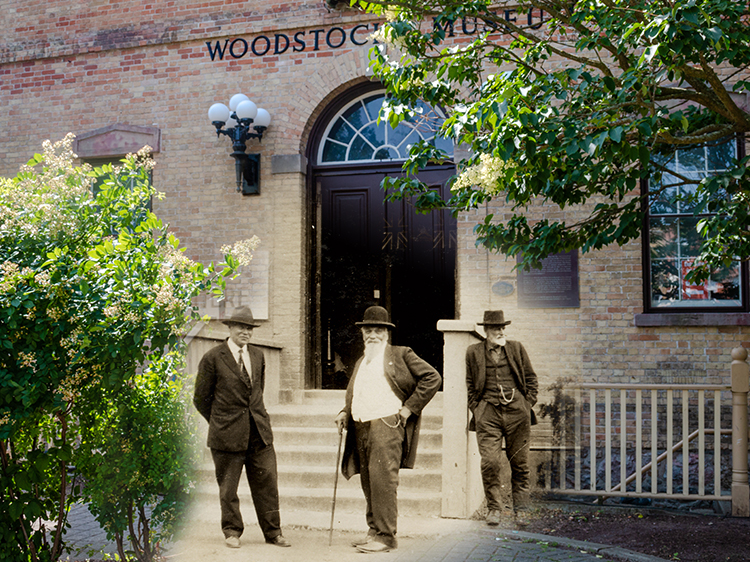Walking Tour
The Steamship Era
Tourism in Parry Sound
Joshua Edmunds
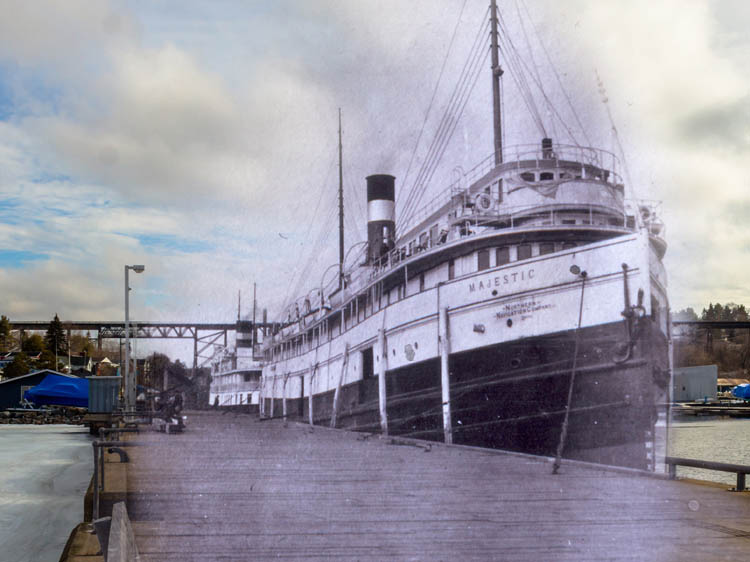
West Parry Sound District Museum 2001.016.1455
On this walking tour, we will explore the rich history of steamships and tourism in Parry Sound, and the impact they had on the community.
The 30,000 Islands are a unique natural wonder, and have been designated a UNESCO World Biosphere Reserve. The dense forests, long coastlines and innumerable lakes are home to over 1,000 distinct types of habitat. That breathtaking beauty has made it a favourite destination for tourists and those seeking rest and relaxation.
Tourism as an industry has a long history in Georgian Bay, and as the regional centre Parry Sound has been a tourist hub since its founding. Opening up the surrounding wilderness to tourism took a long time--roads and railways fit for those seeking to travel in comfort were slow to be built--so until the 1940s the primary means of getting to Parry Sound were the Great Lakes steamers.
The route, however, was anything but safe. Storms, with their high winds and tempestuous waves, could come at any moment and claimed many ships and lives. Nevertheless, for many the risk of being lost at sea was a risk worth taking to witness a Georgian Bay sunrise.
This project is a partnership with the Parry Sound Business Association and the West Parry Sound District Museum.
1. A Port of Call
West Parry Sound District Museum 2001.016.1850
In this photo we see one of the many cruise ships that have visited Parry Sound. For the people of Parry Sound, the arrival of a cruise ship was a momentous occasion. Passengers lined the rails of the ships to catch a glimpse of the town and entertained the local kids by throwing "pennies, nickels, dimes, and, it was rumoured, even quarters" into the waters below.1 The children would dive and swim to catch them.
For many, Parry Sound was a brief port of call, and the passengers had just enough time to stroll the streets and purchase some souvenirs. A favourite stop was Tower Hill, whose commanding view of Georgian Bay was unrivaled. Many were drawn to the excellent quality fishing and hunting opportunities in the area. After the brief visit the tourists would re-embark and continue their exploration of the 30,000 Islands.
* * *
This coincided with the popularization of the summer retreat in northern Ontario--cottage country--which began with the postwar boom in the 1920s. At the time, most individuals travelled by rail in wagons decorated with the latest fashions. Dozens of hotels and luxury resorts were built on the Muskoka Lakes alone, offering leisure without sacrificing luxury. At the time, summer holiday seekers would often stay in Parry Sound and the Muskoka region for weeks or even months. Through a combination of new technology and evolving tastes in holidaymaking, the concept of the Northern Summer retreat was born.
The first hotel in Parry Sound was the Monteith House, which dated to 1879. The Monteith House served as an inn for sportsmen who desired an authentic frontier experience hunting deer and fishing trout or bass. The Monteith House kept a careful eye on emerging trends and reinvented itself from frontier retreat to grand hotel with a reputation for top-notch service that appealed to the growing numbers of holidaymakers. The inauguration of the hotel's golf course incorporated both Scottish designers and a Scottish professional golfer to play the first round.
2. Cheated off their Land
This photo captures indigenous children selling crafts at the Town Dock. These children were from the Wasauksing First Nation reserve on Parry Island, which belongs to the Ojibway, Odawa and Pottawatomi First Nations bands of Treaty 61. There is a certain degree of exaggeration in the costumes of the children which were intended specifically to appeal to the whimsical tastes of the American tourists who visited.
* * *
Instead, Booth capitalized on the vast privileges granted developers by the Indian Act, which required that indigenous peoples surrender lands that were to be used for railways. Booth compelled the indigenous peoples of Parry Island to surrender their lands, paying them a fraction of what they were worth. On that land he built Depot Harbour, and circumvented Parry Sound altogether.
The Indian Act is a fundamentally racist and paternalistic piece of legislation. Passed in 1876 by the federal government, the act's purpose was wholly to assimilate indigenous peoples into the dominant Euro-Canadian settler culture. The act gave government huge power to appropriate the land and resources of First Nations peoples, and forcibly impose cultural practices and identity upon them.
While some meager protections were given to a person who held legal 'Indian' status, they would be forced to surrender that status if they wished to vote, join the military, become a doctor, lawyer, clergyman, or earn a university degree. If an Indigenous woman married a non-Indigenous man, she would relinquish her Indian status. The opposite was not true for Indigenous men, who were free to marry non-Indigenous women and retain their status.1
Business interests, such as resource exploitation and railway construction, were given special carve outs in the act, and it was these carve outs that Booth used to evict the First Nations of Parry Island from their land, and build the community of Depot Harbour.
3. The First Steamer
West Parry Sound District Museum 2001.016.1455
c. 1920s
The steamer pictured here is the Majestic, belonging to the Northern Navigation Company's Georgian Bay & Makinac division. These steamers left Collingwood three times a week during the tourist season for the trip through the North Channel of Georgian Bay to Sault Ste. Marie and beyond. Contemporary brochures describe the scenery at Parry Sound as "entrancing" and "wild and romantic."1 The idea of Georgian Bay as a wild frontier was highly marketable. Describing the wilderness as a mysterious maze of forest, rock, and water, appealed to the imaginations of city dwellers. These brochures took great creative license, but their success was indisputable.
* * *
The challenges for steamships, however, lay in an absence of available infrastructure. There were no sawmills, and all machinery and parts needed to be imported from centres like Toronto and Hamilton. Cockburn's perseverance and determination bore fruit, however, and the steamer, Wenonah, set sail on June 1, 1866. Though Cockburn took some time to turn a profit, the Wenonah quickly became a key part of the region's transportation network. Thomas McMurray wrote in the Free Grant Lands in 1871 of the effect the Wenonah had on the region:
"Ten years ago, the present site of the village of Gravenhurst was a wilderness of pines which flourished in all their primeval grandeur…. The ‘Wenonah' has done good service to the settlers in the Muskoka district during the past few years… I rejoice that she has fostered a trade upon these lakes, which necessitates to the construction of a much larger vessel."1
The Majestic was the natural progression of steamships started by the Wenonah.
4. Littered with Shipwrecks
West Parry Sound District Museum 2001.016.1607
Cruising the Great Lakes was not without its share of peril. The chance of shipwreck, sinking, or fire were real possibilities. In this photo, we witness the sinking of a small steamer the Emma. This Emma could very well be the same Emma that ran into trouble off of Sister Rock Beacon and sank in 1912.
* * *
Others were not so lucky. The unpredictability of the Great Lakes climate, in addition to the tendency to overload vessels and undertake journeys during the perilous months of April and December, heightened the risk. Gale force winds and waves often caused vessels to capsize, or be dashed against rocks.
The waters around the bay are littered with shipwrecks, including the Waubuno and the Asia which resulted in catastrophic loss of life. The Asia sank in 1882 in a hurricane with the loss of 120 lives.
What such wrecks offer is an invaluable opportunity to gaze into a period frozen in time. The cold fresh waters of Georgian Bay have preserved the sunken vessels remarkably well. Today, they draw divers from all over the world. At the Fathom Five National Marine Park for example, there is a total of 22 shipwrecks to explore--a testament to the force and unpredictability of the autumnal gales.1
5. The Georgian Bay Line
The great white steamships, SS North American (background) and SS South American (foreground) were operated by the Chicago, Duluth and Georgian Bay Transit Company throughout the Great Lakes region. The Georgian Bay line carried passengers around the Great Lakes for much of the golden age of steamships, from 1913 until 1967.
* * *
In 1913, the SS North American was launched. It was the inaugural ship of the Georgian Bay Line, as it would become known. Built of steel, the North American had a length of 280 feet. Her sister ship, the larger SS South American, was launched the next year. For much of the 20th Century these two ships were constant fixtures in Parry Sound.
6. The End of an Era
West Parry Sound District Museum Mike Morden Collection
This is another photo of the SS North American. Following World War II competition from cars would bring about the end of the steamship era in Parry Sound, with the last of the Georgian Bay Liners retiring in 1967. Yet in recent years the industry has experienced a resurgence, and now many modern cruise ships operate out of this harbour.
* * *
The growing popularity of the automobile was the death knell of the Great Lakes steamers. The strict timetable of steamers and lengthy journeys could not compete with the freedom and cheapness of cars. Moreover, the Georgian Bay Line's commercial viability was ultimately undermined by the seasonal nature of Great Lakes travel. The lines were effectively operating eight months out of the year, and were at a marked disadvantage against other forms of transport, such as air travel, that functioned year-round. The growing popularity of air travel too meant tourists could venture further afield to exotic destinations, such as Mexico and the Caribbean. In the 1960s American legislation regarding vessel fire safety meant the aging liners were tied up in port indefinitely awaiting expensive refits.
As a result, the SS North American was retired in 1964 after an impressive 51-year lifespan. She sank in the North Atlantic Ocean while under tow, coming to rest off the coast of New England, and submerged in 250 feet of water.
Endnotes
1. A Port of Call
1. John Macfie, Parry Sound Old Times, (Hay Press, 1996).
2. Cheated off their Land
1. Long, Bear, & Boldt, Federal Indian policy and Indian self-government in Canada: An Analysis of a Current Proposal. Canadian Public Policy, 8(2): 189-199, 1982.
3. The First Steamer
1. Paige Phillips, "Muskoka Celebrates 150 Years of Shipping", The Muskokan, (2016), online.
4. Littered with Shipwrecks
1. Adrian Hayes, Parry Sound Gateway to Northern Ontario. (Natural Heritage Books, 2005).
5. The Georgian Bay Line
1. Hayes.
6. The End of an Era
1. "SS North American", Great Lakes Vessels Online Index, online.
Bibliography
Hayes, Adrian. Parry Sound Gateway to Northern Ontario. Natural Heritage Books, 2005.
Long, J.A., Bear, L.L. & Boldt, M., Federal Indian policy and Indian self-government in Canada: An Analysis of a Current Proposal. Canadian Public Policy, 8(2): 189-199, 1982.
Macfie, John. Parry Sound Old Times. Hay Press, 1996.
Phillips, Paige, "Muskoka Celebrates 150 Years of Shipping", The Muskokan, (2016),
"SS North American", Great Lakes Vessels Online Index, online. http://greatlakes.bgsu.edu/vessel/view/005296.




